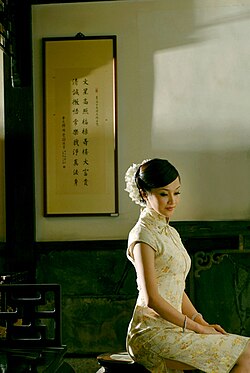Qipao

A woman in a cheongsam
|
|
| Type | Dress |
|---|---|
| Material | Silk, cotton |
| Place of origin | China |
| Cheongsam | |||||||||||||||||||

"Cheongsam" in Traditional (top) and Simplified (bottom) Chinese characters
|
|||||||||||||||||||
| Traditional Chinese | |||||||||||||||||||
|---|---|---|---|---|---|---|---|---|---|---|---|---|---|---|---|---|---|---|---|
| Simplified Chinese | 长衫 | ||||||||||||||||||
| Literal meaning | "long gown" | ||||||||||||||||||
|
|||||||||||||||||||
| Transcriptions | |
|---|---|
| Standard Mandarin | |
| Hanyu Pinyin | chángshān |
| Bopomofo | ㄔㄤˊ ㄕㄢ |
| IPA | [ʈʂʰǎŋʂán] |
| Yue: Cantonese | |
| Yale Romanization | chèuhng-sāam |
| IPA | [tsʰœ̭ːŋsáːm] |
| Jyutping | coeng4-saam1 |
The cheongsam (/ˈtʃiːɒŋˈsæm/,/ˈtʃɒŋˈsæm/ or /ˈtʃɒŋˈsɑːm/) is a body-hugging one-piece Chinese dress for women, also known as qipao (from Mandarin Chinese: ; pinyin: qípáo; Wade–Giles: ch'i-p'ao; IPA: [t͡ɕʰǐ pʰɑ̌ʊ̯]), and Mandarin gown. The stylish and often tight-fitting cheongsam or qipao (chipao) that is best known today was created in the 1920s in Shanghai and made fashionable by socialites and upper class women.
The English loanword cheongsam comes from chèuhngsāam (; "long shirt/dress"), the Cantonese pronunciation of the Shanghainese term zǎnze or zansae, by which the original tight-fitting form was first known. The Shanghainese name was somewhat in contrast with usage in Mandarin and other Chinese dialects, where chángshān (Mandarin) refers to an exclusively male dress (see changshan) and the female version is known as a qípáo.
...
Wikipedia
